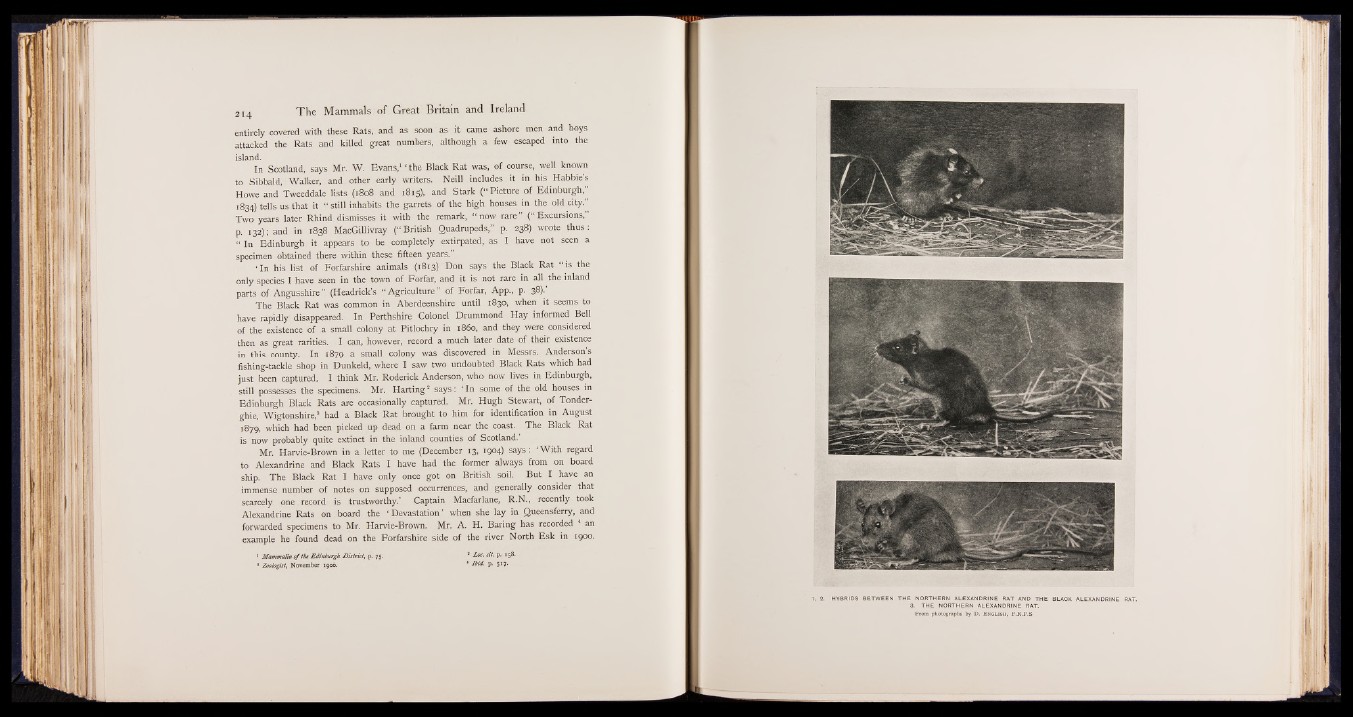
entirely covered: with these Rats, and as soon as it came ashore men and boys
attacked the Rats and killed great numbers, although a few escaped into the
island.
In Scotland, says Mr. W. Evans,1 ‘ the Black Rat was, of course, well known
to Sibbald, Walker, and other early writers. Neill includes it in his Habbie's
Howe and Tweeddale lists (1808 and 1815), and Stark (“ Picture of Edinburgh,”
1834) tells us that it " still inhabits the garrets of the high houses in the old city.”
Two years later Rhind dismisses it with the remark, “ now rare ” (“ Excursions,,” .
p. 132); and in 1838': MacGillivray (“ British Quadrupeds,” p. 238) wrote thus:
“ In Edinburgh it appears to be completely extirpated, as I have not seen a
specimen obtained there within these fifteen years.”
‘ In his list of Forfarshire animals (1813) Don says the Black Rat h is fhe
only species I have seen in the town of Forfar, and it is not rare in all the inland
parts of Angusshire” (H e a d r ic k ® Agriculture ” of Forfar, App., p. 38)-’
The Black Rat was common in Aberdeenshire until 1830, when it seems to
have rapidly disappeared. In Perthshire Colonel Drummond Hay informed Bell
of the existence of a small colony , at Pitlochry in i860, and they were considered
then as great rarities. I can, however, record a much later date of their existence
in this county. In 1879 a small colony. was discovered in Messrs. Anderson s
fishing-tackle shop in Dunkeld, where I saw two undoubted Black Rats which had
just been captured. I think Mr. Roderick Anderson, who now lives in Edinburgh,
still possesses the specimens. Mr. Harting3 says: ‘ In some of the old houses in
Edinburgh Black Rats are occasionally captured. Mr. Hugh Stewart, of Tonder-
ghie, Wigtonshire,8 had a Black Rat brought to him for identification in August
1879, which had been picked up dead on a farm near the coast. The Black Rat
is now probably quite extinct in the inland counties of Scotland.
Mr. Harvie-Brown in a letter to me (December 13, 1904) says: ‘With regard
to Alexandrine and Black Rats I have had the former always from on board
ship. The Black Rat I have only once got on British soil. But I have an
immense number of notes on supposed occurrences, and generally consider that
scarcely one. record is trustworthy.’ Captain Macfarlane, R.N., recently took
Alexandrine Rats on board the ‘ Devastation’ when she lay in Queensferry, and
forwarded specimens to Mr. Harvie-Brown. Mr. A. H. Baring has recorded 4 an
example he found dead on the Forfarshire side of the river North Esk in 1900.
1 Mammalia o f the Edinburgh District, p. 75.
* Zoologist, November 1906.
3 Lac. cit. p. 158.
* Ibid. p. 517.
HYBRIDS BETWEEN THE NORTHERN ALEXANDRINE RAT AND THE BLACK ALEXANDRINE RAT.
3. THE NORTHERN ALEXANDRINE RAT.
From photographs by D. English, F.R.P.S